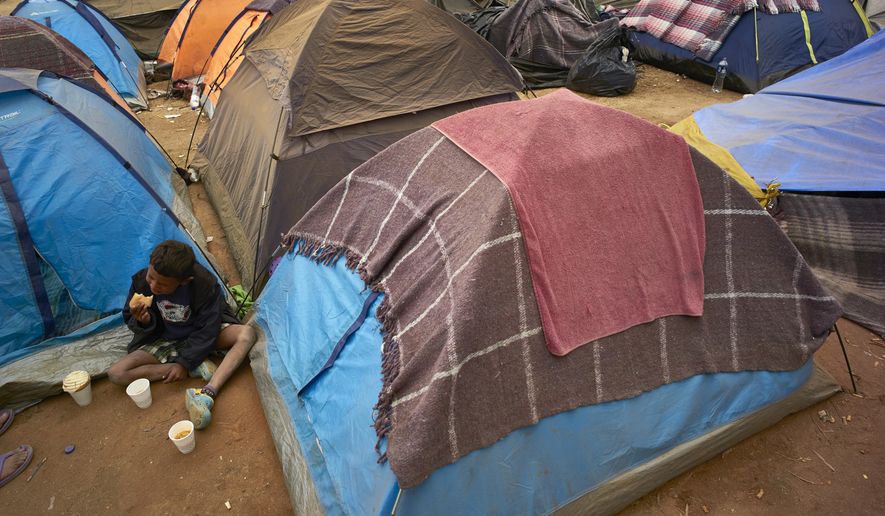The Central Americans surging into the U.S. and claiming asylum look a lot more like regular illegal immigrants, eager for better jobs or to reunite with families, than traditional refugees fleeing persecution or violence back home, according to a new report Wednesday that challenges conventional wisdom on the migrants’ motives.
And while they are often referred to as asylum-seekers, few of the migrants from Guatemala, Honduras and El Salvador — the chief sending countries — are likely to end up winning asylum in the U.S., according to the study by academics at the National Center for Risk and Economic Analysis of Terrorism Events (CREATE) at the University of Southern California, and the Institute for Defense Analyses.
Adults are most likely to come for better jobs, the researchers said. They can improve their incomes by 1,200 percent in moving from Central America to the U.S. Children, meanwhile, are coming for economic opportunities but also to reunite with family already in the U.S., they concluded.
“The standard wisdom [that] it’s all about violence could not be supported by our data,” said Detlof von Winterfeldt, a researcher at CREATE.
The academics also found that policy debates in Mexico and the U.S. do correlate with surges in migration, with flash points like President Obama’s 2012 DACA program and the 2013 U.S. Senate debate over legalizing illegal immigrants being followed by increases in Central Americans attempting to enter the U.S. without permission.
By contrast, expectations of tough enforcement at the beginning of the Trump administration correlated with an historic drop in illegal immigration.
SEE ALSO: MS-13 gang member caught with migrant caravan
For years, the two sides in the immigration debate have sparred over the change in demographics. Mexicans, who used to make up nearly all of the unauthorized flow across the southwest border, have dissipated, but Central Americans have soared this decade.
Immigrant-rights activists say the Central Americans are asylum-seekers fleeing horrific gang violence and government indifference back home. They point to murder-rate statistics as key evidence for the “push factor.”
The Trump administration, though, argues that the “pull factors” of family already in the U.S., the chance for better jobs ,and the low risks of being turned back are more important.
The new report, which was submitted to the Homeland Security Department, which supported the research, said there’s mixed evidence on violence being a factor, but said the evidence on the pulls is more clear.
And the researchers put data behind what analysts have long guessed: migrants from Central America appear to have figured out how to navigate U.S. humanitarian laws to their own benefit.
Some time around 2012, juveniles and families began to change their patterns and rather than sneak in and hope to disappear, most began to show up and present themselves to the first authorities they could find, and ask for asylum.
Though relatively few were likely to win those claims, just asking for asylum “basically guaranteed” entry for juveniles, and made entry “more likely than not” for adults.
The Trump administration is pushing Central Americans with legitimate asylum claims to make them in Mexico, which is considered a “safe” country. But the report explained that’s not likely.
Not only won’t they be able to earn as much in Mexico, but the family networks of Guatemalans, Hondurans and Salvadorans just don’t exist in the same numbers in Mexico as they do in the U.S., making the country a pathway instead of a destination.
“These findings suggest that there will be very little diversion of asylum seeker flow from the United States to Mexico if seeking asylum in the United States is not an option,” the study concluded.
The academics used myriad yardsticks to reach their conclusions, including surveys of how people perceive violence in their countries, polling of migrants and their motivations, and employment conditions.
They asked questions about the cost-benefit analysis migrants are likely making about moving to a safer place within their own country, moving to Mexico, or moving to the U.S. They concluded that few people who decide to leave their home country in Central America will move to Mexico, because the average migrant only sees a 10 percent wage increase.
If they come to the U.S., though, they see a 1,200 percent wage increase, which makes the trip far more worth it.
The study was released a day after another report by the Pew Research Center concluded that overall illegal immigration to the U.S. dropped in 2016, to 10.7 million, down from a peak of 12.2 million in 2007 and the reaching the lowest levels since 2004.
Fueling the drop is a major decline in the number of Mexican illegal immigrants, from nearly 7 million in 2007 to fewer than 5.5 million in 2016. South America’s unauthorized migrant population also dropped by nearly 250,000 people.
But the number of illegal immigrant Central Americans — chiefly Honduras, El Salvador and Guatemala — has surged by 25 percent over the last decade, closing in on 2 million.
Asia, the Middle East and Africa remained largely unchanged over the decade, Pew estimated.
The researchers said of the 10.7 million, more than 1 million of them have gained a tentative status through programs such as the Obama-era DACA policy, or humanitarian Temporary Protected Status.
Pew also said there are marked differences in how illegal immigrants reach the U.S.
While most Mexicans and Central American illegal immigrants jumped the southwest border without permission, those from elsewhere usually came on legal visas then refused to leave when their time was up.
• Stephen Dinan can be reached at sdinan@washingtontimes.com.




Please read our comment policy before commenting.